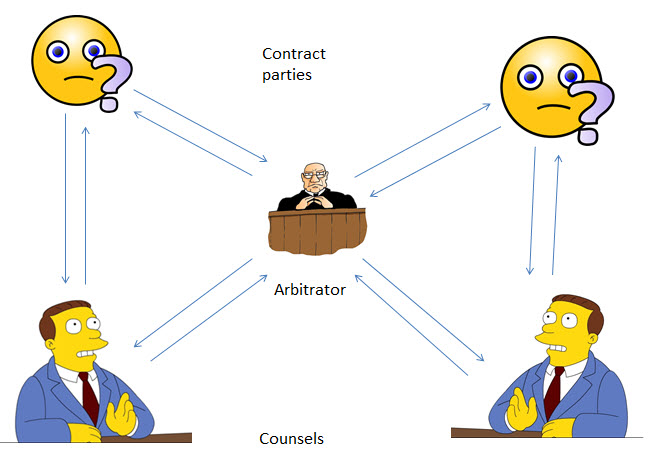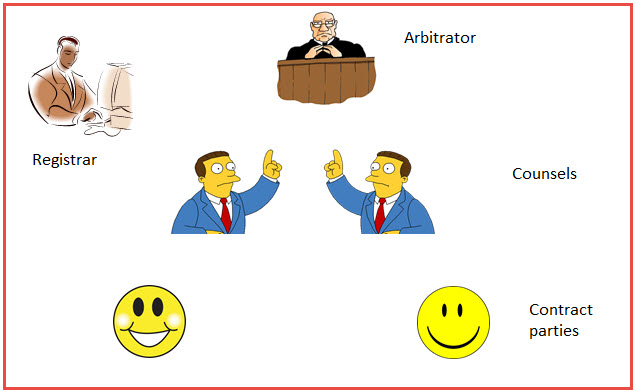This is a continuation of the Part I of the article on Virtual ODR
“Virtual ODR” is the ODR system that is adopted by Arbitration.in. It is an ODR system in the sense that it is an “Online” system for conducting Dispute Resolutions such as Arbitration or Mediation. But it is different from the so called ODR systems which are being presently used worldwide and let’s try to understand the differences.
In the ODR system that is generally used, the Website that offers the services functions like a “Arbitral Center”. The person who invokes the  system (claimant) sends a request by e-mail to the center with necessary information about the respondent. The Center appoints an Arbitrator and forwards the claimant’s request to him. There after, the Arbitrator takes over and sends an e-mail notice to the respondent. When the response is received, it is communicated to the claimant and his response to the respondent’s reply is sought. Arbitrator will decide when the chain of correspondence has to be closed and declare that he has all the necessary information to take a decision and proceeds to convey his award.
system (claimant) sends a request by e-mail to the center with necessary information about the respondent. The Center appoints an Arbitrator and forwards the claimant’s request to him. There after, the Arbitrator takes over and sends an e-mail notice to the respondent. When the response is received, it is communicated to the claimant and his response to the respondent’s reply is sought. Arbitrator will decide when the chain of correspondence has to be closed and declare that he has all the necessary information to take a decision and proceeds to convey his award.
In this entire process, lot of time is wasted in waiting for the response from the other party and even when received, it may be incomplete and need clarification. Hence the process may have to go through several cycles of exchanges unless the Arbitrator puts his foot down and rules that the exchange of responses will be allowed only once or twice. This may leave the disputing parties dissatisfied. Additionally, if the process is challenged in a Court, there will be needless discussions on what the Arbitrator did or did not do.
On the other hand the Virtual ODR system of Arbitration.in functions principally as a service provider to the Arbitrator. Where required, it 
may provide back office services but all proceedings will be done in the name of the Arbitrator only and the website only acts as an intermediary service provider.
The actual process of arbitration is conducted in a virtual meeting room. While e-mails are exchanged initially, it is for issue of access credentials to the people who have to be present and not on the proceedings.
If the parties need to introduce evidence in the form of lengthy documents which need to be studied by the other party, it may be sent by e-mail as advance information but are confirmed during the virtual session. However the face to face (virtual) meeting in which the parties, their counsels and the Arbitrator meet together enables all discussions to take place in a virtual replication of a physical meeting. Even witnesses can be examined in the same room. In view of the meeting of all parties in one place, small differences of opinion can be settled quickly and to the satisfaction of all parties. There is therefore better clarity on the views of either parties and saving of repeated exchanges of e-mail just to present points and respond to the points raised by the other.
Additionally, the Registrar of the Arbitration.in will be present during the session and take complete notes of all the proceedings by simply making a video recording of the entire process. This results in complete transparency when the proceedings are to be discussed later when challenged in a Court. Since the recording is certified by the Registrar under Section 65B of Indian Evidence Act, it is admissible as evidence in any Indian Court under law.
Hence the Virtual ODR process is distinctly superior in terms of not only operating efficiency but also in terms of judicial acceptance.
This type of Virtual ODR with certification of proceedings is considered unique and innovative.
I hope the Arbitration community appreciates the benefits and start using the system.
Naavi
Any Arbitrator or Arbitral House requiring training or more clarification can contact Naavi






